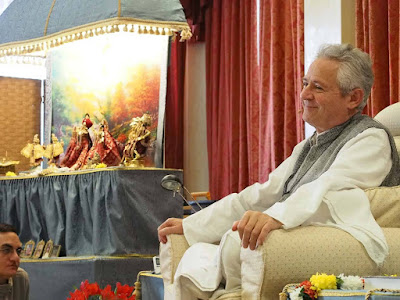Part I
A pilgrimage is a journey in search of the Divine inside and outside us.
It does not take place within a physical space, rather it occurs in one’s mind and consciousness. Its most intimate purpose is a deep purification of the heart, of the intellect, of the memory, and of our being in its wholeness. If we live the Pilgrimage deeply and authentically, it may represent a turning point, a special experience, that, due to an extraordinary combination of elements, favouring the purification of consciousness, may allow us a sudden advancement, which possibly we would have not been able to achieve even through a number of previous lives.
According to the Indovedic literature, the spiritual vitality of the pilgrimage location is related to the daily renovation of its sanctity by the holy people living there.
In the Shrimad Bhagavatam this concept is explained very clearly: they believe that holy people themselves are pilgrimage places. In the first canto of this wonderful masterpiece, King Yudhisthira says to the great sage Vidura:
“Noble soul, the devotee who have the qualities of Your Divine Grace are themselves regarded as pilgrimage places. As you bring God in your heart wherever you go, the places you visit become holy places” (I.13.10)
When we enter a sacred place, in Sanskrit called tirtha, we meet the Divine (murti) and awaken people, sadhu, and this way, if we incline ourselves properly, we can be pervaded by a great spiritual power, the same energy that permeates those places, behaviours and gestures of ancient sacred value. This spiritual energy, which, in holy places, is brilliant and vibrating, can strengthen us in order to improve our personality and our changes in life, that, otherwise, we would have never accomplished for lack of will and courage. Like a magnet that energy and spiritual strength attracts our deepest thoughts and feelings, our ideal aspirations, and brings us along a path of wonderful search for rediscovering ourselves, the origins of our life, and our highest realization.
First of all the pilgrimage place is an instrument to acquire virtue and knowledge, not a “horizontal” knowledge, limited to the things of this world, but a “vertical” knowledge that rises up to the highest pinnacles of awareness. For this reason we consider a pilgrimage like a journey between the earth and the sky: from the earth it takes us to the sky and from the sky it brings us back to earth, transferring in our daily life the intuitions, the comprehensions, and the realizations that we have experienced, welcomed, and harboured during the Journey.
All the efforts and inconveniences connected to travelling are part of the path of elevation. They should not to be seen as obstacles, rather they are extraordinary opportunities to overcome our limits, to dispose of illusions and attachments. When we travel, it is easier to understand that none of the things outside of us belong to us. Who can claim to own wealth? Can we have power over youth or health? For how long? Those resources are given to us for a brief length of time and their quality and evolving utility depends on how we use them. Who can say “I possess a body”? In truth, we are not even the owners of our body, and if we want to keep it forever, we would not be able to do it: it would be impossible. Sooner o later it will be taken away from us regardless of our will. We do not own whatever is outside us, we can only take care of it temporarily. However the soul and its powers belong to us, and they are inalienable and immensely great: the knowledge of the truth, the joy of the self, the nature of eternity. The essence of life is to regain awareness of those intrinsic qualities we have lost, choked by the conditionings, and the contaminations of our character. During the Journey each one of us has the rare opportunity to achieve the discovery of the soul’s treasures.
Furthermore the journey exhorts us for a continuous effort of discerning, to separate virtuosity from vice, reality from illusion, sacredness from profane, the inner world from the outside world, aimed to avoid the mistake of exchanging the pure from the impure and vice versa. Holy places are not meant to be seen with your own eyes, we need to predispose ourselves with an elevated consciousness and visit them with the company of people who live and search santity, otherwise we run the risk to limit our vision at the physical level, and to be confused by external appearances.
The sacred place is a state of mind, not a physical reality. It is the reality of the soul where there is genuine love, control over impulses, caring for each other, awareness of the presence of God. During our pilgrimage in sacred places we may come across holy scenes, moments of eternal sacredness, but also situations of degradation and low civilization, exactly like one person may harbour elevated expressions of geniality and kindness together with abysses of degradation. This is why it is fundamental to develop and keep a clear vision about brightness and darkness, without letting slip from memory what is holy just because we saw what is not holy, taking a distance from the degradation only because it is often placed next to what is sacred.
For this reason, in order to feel the spirit of a holy place with this high sense of discernment, it is fundamental to be in company of people motivated like us, sharing the same purposes, and even better – with people who are already able to perceive the essence separated from what is redundant and superficial, via the teachings of the sacred scriptures.






















